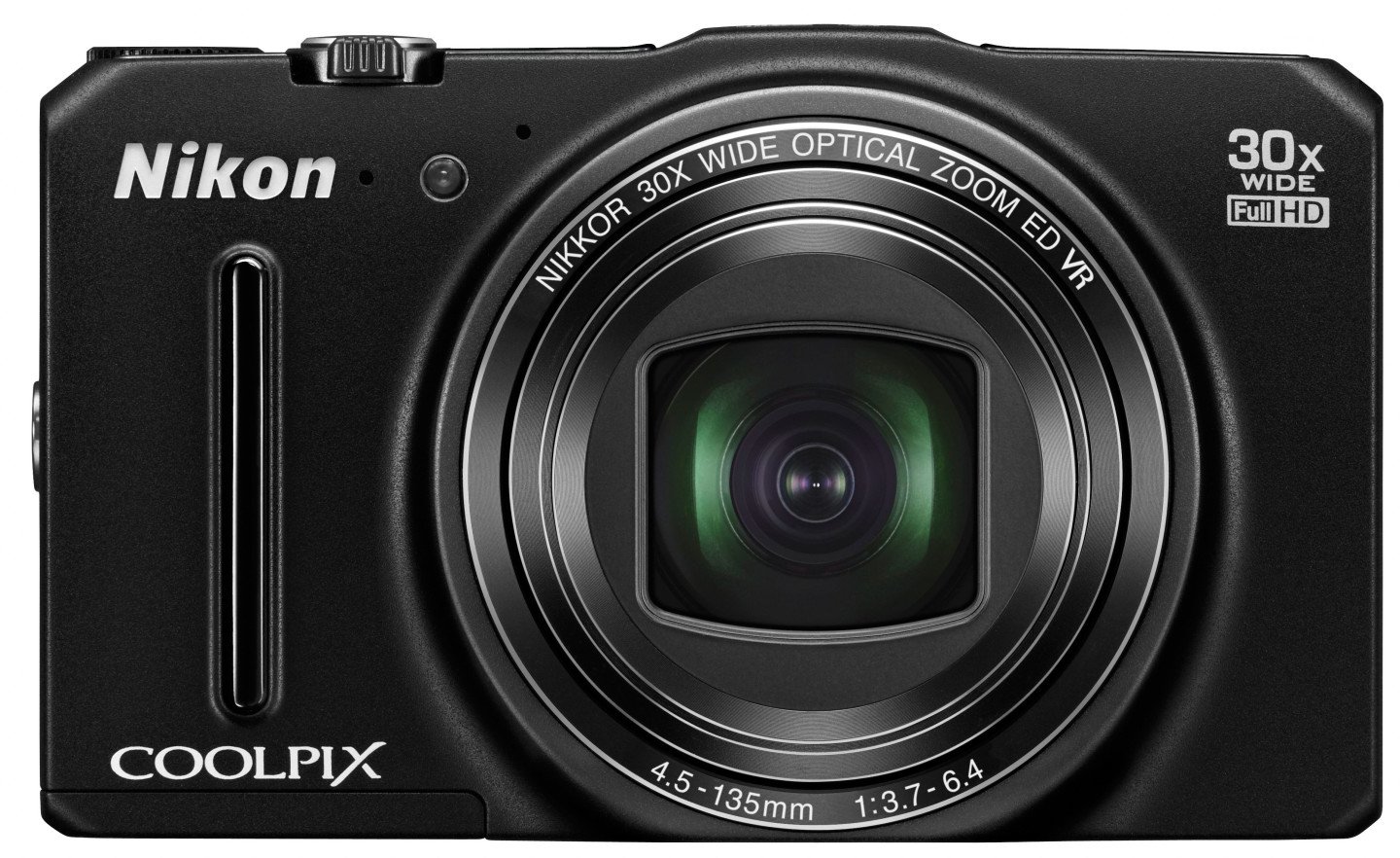Nikon COOLPIX S9700 review
-
-
Written by Ken McMahon
Intro
The Nikon COOLPIX S9700 is a compact travel zoom with a 30x optical zoom lens, a 16 Megapixel CMOS sensor and a 3 inch OLED screen with a 921k dot resolution. The COOLPIX S9600, launched at the same time, has a shorter 22x zoom, a lower resolution screen, lacks the built-in GPS and of course is priced a little lower.
Both models support fully manual exposure control with PASM modes selected from a conventional mode dial alongside a fully auto point-and-shoot mode and feature scene detection and composite stacking modes for HDR and low noise shooting.
The COOLPIX S9700 has built in GPS as well as Wifi, a popular combination in a travel zoom. Add in full resolution burst shooting at 6.9 fps, a wide range of movie modes including 1080p full HD and a choice of slow motion settings, and you’ve got a very capable sounding travel zoom which ticks all the boxes at a competitive price. To find out if the real-life performance lives up to its promise, I tested the COOLPIX S9700 alongside Canon’s PowerShot SX700 HS. Both models were launched during 2014 and updated in early 2015 to the S9900 and SX710 HS respectively. During the transition from one version to the other, bargains can often be found, so I thought it would be interesting to see how these pair of potentially discounted cameras compared. So read on to find out which of these two is the best bet for those looking for a powerful zoom in a compact form factor at a competitive price.
Nikon COOLPIX S9700 design and controls
In terms of size and weight, most of the popular recent compact super-zooms are very closely matched and the COOLPIX S9700 is no exception. It measures 109.6×63.5×34.5mm and weighs 232g including battery and card. Generally, if you want a smaller body you’re going to have to sacrifice zoom range and if you want a longer zoom you’ll be looking at bigger, heavier models. The COOLPIX S9700 will fit in your jacket or coat pocket.
With dimensions of 113x66x34.8mm the Canon PowerShot SX700 HS is a tiny bit taller and wider, but I reckon Canon and Nikon must be doing their measuring differently because back-to-back on the desk in front of me I can’t see a significant difference. At 269g with battery and card fitted the SX700 HS is a little heavier though. The Panasonic Lumix TZ60 / ZS40 is pretty much identical at 111x64x34.4mm and 240g and the same almost goes for the Sony Cyber-shot HX50V / HX60V, at 108x64x38.3mm it’s a fair bit thicker giving it a much chunkier appearance.
The plastic body is finished in gloss paint and is available in black, red or white. It feels sturdy enough and all the doors and flaps fit nicely, with the exception of the pop-up flash, which sits a little proud of its recess in the top panel. Opposite, on the other side of the slight hump that houses the Wifi aerial, there’s a recessed on/off button, shutter release with zoom collar and the mode dial which is set into the top panel with an exposed rear section that can be operated with your thumb.
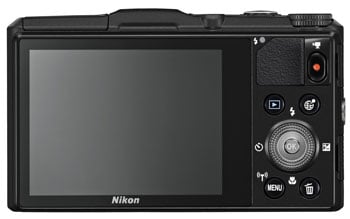 |
On the rear panel the control layout is much the same as on the earlier COOLPIX S9500 with a slightly larger thumb pad. The movie record button is a little lower but still conveniently positioned for thumb operation and the multi-selector wheel below it is used for menu navigation as well as one-touch access to flash, exposure compensation, focus and self-timer settings. There’s also a new button that displays a map view, showing either your current location or the location of reviewed images.
The COOLPIX S9700 has a fixed 3 inch OLED screen with 921k dot resolution. There’s no question that this is a good quality screen, the image is highly detailed and very stable. The colour looks accurate (though obviously this doesn’t affect image quality) and the image is nice and contrasty, making it easy to see in all but direct sunlight. The OLED screen also has a wide angle of view, so you can still see pretty well even with the camera held at high and low angles.
The PowerShot SX700 HS has a 3 inch LCD screen with the same resolution as the COOLPIX S9700’s and there really isn’t much to choose between them. Like the COOLPIX S9700, the S700 HS display is bright, punchy and detailed. Note the more recent COOLPIX S9900, updates the S9700 with a fully articulated screen, a unique feature among its peer group. As for the latest Canon SX710 HS, the screen is the same as its predecessor.
 |
On the right side of the S9700’s body there are two small doors above and below the central wrist strap fitting. The lower one is a mini HDMI port for connection to an HD TV with an optional cable. The upper one is a USB port that is used to charge the camera as well as for transferring photos and video from the card or the built-in memory. You can charge the camera via this port using either the supplied mains charger, or by plugging it into a notebook or other suitable power source. Personally, I think this is a more versatile and useful approach than that used by the PowerShot SX700 HS where the battery has to be removed and placed in an external charger. Having said that the latter method means you can still use the camera while the battery is charging if you have a spare.
The COOLPIX S9700’s EN-EL12 battery provides enough power on a full charge for 300 shots – 50 more than the PowerShot SX700 HS. But if you’re prepared to have the SX700 HS dim the screen after a couple of seconds and switch off after 3 minutes, Eco mode will extend the battery life to 360 shots.
The COOLPIX S9700 has a built-in flash that automatically pops up when required. There are four modes selected from a menu which appears when you press the top position on the the Multi selector wheel – Off, Red-eye reduction, Standard and Slow sync. The quoted range is 6 metres at the lens wide angle setting, on the face of it more powerful than the PowerShot SX700 HS, but I suspect the figure for the COOLPIX S9700 is quoted at a higher ISO. Neither the COOLPIX S9700 nor the PowerShot SX700 IS has a hotshoe, but the SX700 HS is compatible with Canon’s HF-DC2 external flash.
Nikon COOLPIX S9700 lens and stabilisation
The COOLPIX S9700’s 30x optical zoom has the same 25-750mm equivalent range as the PowerShot SX700 HS, but its f3.7 – 6.4 aperture isn’t quite as bright at the wide angle end of the range as the latter’s f3.2 – 6.9. The compensation is that it’s a little brighter at the telephoto end of the range. Note the latest versions of both cameras share the same lenses as their predecessors.
The 25-750mm equivalent range is impressive in a compact this size, and while there are other 30x compact zooms, the Lumix TZ60 / ZS40 and the Sony HX50V / HX60V being two examples, both of those models start at a slightly wider 24mm wide angle and fall short of the COOLPIX S9700’s telephoto reach by 30mm – so that’s a 24-720mm range compared with 25-750. In practice the difference is barely noticeable, but if you’re stuck in a tight corner, the fractionally wider Sony and Panasonic may be more useful. That said, there’s always the COOLPIX S9700’s Easy panorama mode for really wide views, something the PowerShot SX700 HS lacks. Redressing the balance, the SX700 HS Framing assist button helps you keep track of subjects when zoomed in, something that’s not quite so easy on the COOLPIX S9700.
Nikon COOLPIX S9700 coverage wide | Nikon COOLPIX S9700 coverage tele | |
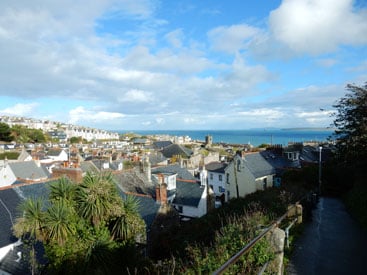 |  | |
| 4.5-135mm at 4mm (25mm equiv) | 4.5-135mm at 135mm (750mm equiv) |
The COOLPIX S9700 has optical image stabilisation which Nikon calls Vibration Reduction or VR. Vibration reduction is set separately for stills and movie shooting with Photo VR activated from the Setup menu. In addition to the On and Off positions there’s a third option called Hybrid. This combines the optical stabilisation with in-camera post processing to digitally remove any blurring that remains. The digital correction is applied only under certain conditions, including when the shutter speed is slower than 1/30 at the wide angle setting or 1/250 at the telephoto focal length and when the sensitivity is 200 ISO or lower.
In addition to Vibration Reduction, Motion detection automatically raises the ISO sensitivity to enable selection of a faster shutter speed when either subject movement is detected or there’s a risk of camera shake. It’s quite a useful feature for beginners, who might be unaware of the consequences of shooting at slow shutter speeds, but it can be turned off and manual selection of the ISO sensitivity also disables it.
To test the COOLPIX S9700’s stabilisation I set it to Shutter priority exposure mode, zoomed the lens to its maximum 750mm equivalent telephoto setting and took a series of shots at progressively slower shutter speeds, first with Photo VR turned off and then with it on. As you can see from the crops below, the COOLPIX S9700 can produce blur-free shots down to 1/50 at the maximum zoom range, I managed the occasional sharp shot at 1/25 but for consistency 1/50 is the limit, at around four stops slower than the photographer’s ‘one over the focal length’ dictum suggests is safe, that’s pretty impressive by any standards.
Nikon COOLPIX S9700 Vibration Reduction
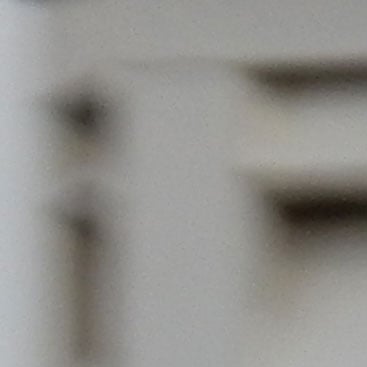
100% crop, 4.5-135mm at 135mm, 125 ISO, 1/50th VR off.

Nikon COOLPIX S9700 shooting modes
Compared with the PowerShot SX700 HS, the COOLPIX S9700’s mode dial is relatively uncomplicated with positions for PASM modes, Auto, Scene, Effects and a smiley face icon indicating Smart portrait mode. Program Auto sets the aperture and shutter speed automatically, Aperture Priority lets you set the aperture and the shutter speed is set automatically, Shutter priority is the other way around and in Manual mode you set both the aperture and shutter speed. If this is new territory for you, the COOLPIX S9700 is the ideal camera to learn about these manual and semi-auto modes in practice.
In the meantime, The green camera icon on the mode dial puts the COOLPIX S9700 into Auto mode. The difference between this and Program Auto is that there’s less for you to do. You can change the image size and quality from the shooting menu and adjust exposure compensation, but you can’t shift the exposure (adjust the aperture and shutter speed whilst maintaining the same exposure value), adjust the ISO sensitivity, white balance or any of the other options available from the Shooting menu in Program auto mode.
Switch the mode dial to the Scene position and the menu offers 18 scene modes including all the usual suspects from Portrait to Party via Landscape, Sports, Beach, Fireworks show, and Backlighting. There are two panorama modes for shooting 180 and 360 views. You press the shutter once and pan the camera as smoothly a you can. You can pan with the camera in portrait or landscape orientation – the COOLPIX S9700 works out which, you don’t need to tell it beforehand. Portrait mode produces the largest images which are 1536 x 4800 pixels for 180 panoramas and the 360 ones measure 1536 x 9600.
While it isn’t one of the best HDR modes around, the COOLPIX S9700 features Nikon’s Backlighting scene mode. HDR mode fires a fast burst of bracketed shots and produces a composite HDR image from them. The COOLPIX S9700 also includes a selection of 11 special effects filters – Soft focus, Pop, Super vivid, Cross process, two toy camera effects , Nostalgic Sepia, High-contrast monochrome, High key, Low key and Selective colour. Other than selecting the colour from an on-screen palette for the Selective colour effect and choosing one of four cross process colours, none of them is customizable. All can be used for movies but note there’s no Miniature effect like on the SX700 HS. Below you can see Nostalgic sepia, High-contrast monochrome, Selective colour, Pop, Cross process, and Toy camera effect 2 .
 |  |  |
 | 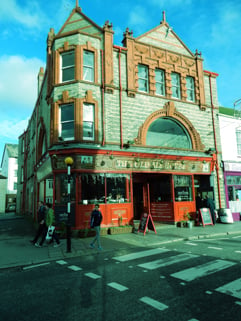 | 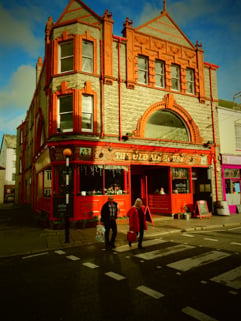 |
The shooting menu also offers something called Quick effects. With this activated you can apply effects filters to a shot just after you’ve taken it. Effects include Pop, Super vivid, Painting, Photo illustration, High key, Toy camera effect, Cross process, fish-eye, miniature and selective colour. To apply the effect you press the OK button in the centre of the Multi selector while the image preview is on the screen, but in fact you can apply the effects an any time by pressing the OK button when previewing images in playback mode. The filtered version is saved along with the original. Quick effects can’t be applied to movies, so, alas, no miniature effect for movie clips.
Finally, Smart Portrait mode automatically takes a shot when it spots a smile in the frame. It doesn’t offer the wink and face self-timer functions of the SX700 HS, but you can apply a skin softening filter, shoot in continuous or BSS modes and set blink detection.
Nikon COOLPIX S9700 movie modes
The COOLPIX S9700 has a best quality HD movie mode of 1080p25 which is encoded at an average bit rate of around 17Mbps. All of the video modes are available in PAL and NTSC compatible frame rates (i.e. 25/30 and 50/60fps) depending on the frame rate setting in the Movie menu, from here on I’ll use the PAL specifications. Next on the menu is an interlaced 1080i50 mode, followed by 720p25. That’s followed by a another 720p mode saved in Apple’s edit-friendly iFrame format, and lastly a VGA mode that records 640×480 resolution video at 25fps (or 30fps for NTSC video mode).
That’s just the normal speed modes; the COOLPIX S9700 also has several HS options for playback at speeds other than real time. HS480/4x shoots 640×480 video at 4x normal speed (100 or 120fps depending on whether you have PAL or NTSC video mode selected) which plays back at quarter speed. HS720/2x records 1280×720 at double the normal frame rate for half speed playback, and finally 1080/0.5x records full HD video at half the normal frame rate for double-speed playback.
Audio isn’t recorded with the HS video modes but I was pleasantly surprised to discover that you can use the effects filters. The only limitation on this is that the Soft and Nostalgic sepia effects are only available with the HS720/2x mode. I should also mention that you can’t use the use zoom or Full-time AF with the HS modes. That said, although they’re fairly even matched in terms of video modes, the PowerShot SX700 HS only offers low resolution VGA (640×480) and QVGA (320x 240) modes at 1/4 and 1/8 speed playback respectively.
The COOLPIX S9700 doesn’t have a movie position on the mode dial, so recording is started by pressing the dedicated record button whatever mode you’re in. One of the drawbacks of this approach is that you can’t frame up your shot very easily as the screen switches from 4:3 proportions to 16:9 (assuming you’re shooting in one of the HD modes). The PowerShot SX700 HS mode dial movie position makes this much easier, but the COOLPIX S9700 does at least have a display mode that superimposes the 16:9 area on the 4:3 screen for you.
The COOLPIX S9700 provides two autofocus modes for movie shooting, Single AF (AF-S), which sets the focus at the beginning of your clip and Full time AF (AF-F) which continually adjusts it. AF-S is the default, but if you want to record anything that’s moving, or if you’re panning the camera from near to far subjects, you need to switch to Full-time AF. The COOLPIX S9700’s full-time AF mode works very well. The only thing that taxed it was zooming, as you can see from my coffee cup test below it copes well, keeping focus on the subject even in low light conditions.
The COOLPIX S9700 doesn’t support any of the PASM exposure modes for movie shooting, regardless of the position of the mode dial and ISO, the sensitivity and exposure are set automatically. In that respect it’s the same as the PowerShot SX700 HS.
| |
|---|---|
| |
| |
| |
|---|---|
| |
| |
| |
|---|---|
| |
| |
| |
|---|---|
| |
| |
Nikon COOLPIX S9700 handling
The COOLPIX S9700 is a little slower than the PowerShot SX700 IS to start up, it takes a couple of seconds to extend the lens and ready itself for shooting, but that’s fairly average. It also takes a couple of seconds for the zoom to travel its full optical range at the faster (and noisier) of its two speeds, which is swift, but the fine motor control is a little haphazard which sometimes makes it a bit of an effort to precisely frame your shot.
In Auto modes the menu system is more than adequate, which is another way of saying it’s fine if you don’t use it much. In PASM modes when you’re more likely to want access to ISO sensitivity, metering and AF modes and the like, it can be a bit cumbersome. The problem is the lack of a quick menu of some kind. The PowerShot SX700 HS’s Func. Set button makes changing common settings a great deal quicker and easier.
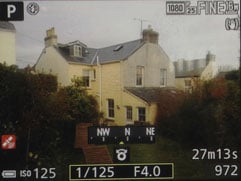 |  | 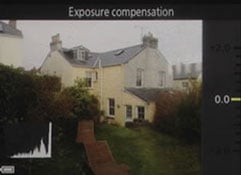 |
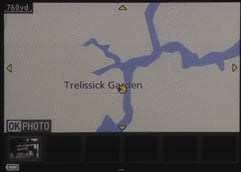 |  | 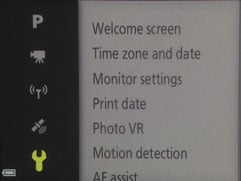 |
Like the SX700 HS the COOLPIX S9700 has built-in Wifi. There’s no NFC chip in the COOLPIX S9700 though, so connection isn’t a straightforward for those with NFC equipped smartphones; note the newer S9900 does have NFC. That said, to connect to the COOLPIX S9700 all you need to do is enable Wifi from the menu then select the COOLPIX S9700’s SSID on your phone. Before you do that, it’s advisable to set up security options on the camera, otherwise you’ve got an open Wifi connection that anyone can tap into.
Once that’s done you have the option of remote shooting using Nikon’s Wireless Mobile Utility app as well as downloading images from the card in the camera. The remote shooting features are pretty basic. Regardless of the mode dial position the camera shoots in Auto mode and there’s no exposure control available, not even exposure compensation. You can zoom the lens in fairly stacatto steps and there’s a noticeable lag between tapping the control on your phone and the camera responding.
Downloading images from the camera’s card to the phone is straightforward, You can view the images in a grid, get a full screen look at a low resolution preview and select it for download at one of three sizes – the original, or a down sampled file at VGA (640×480) or something called ‘Recommended size’. It took around eight seconds to download an original 6MB image from the COOLPIX S9700 to my iPhone with the two devices about a metre apart.
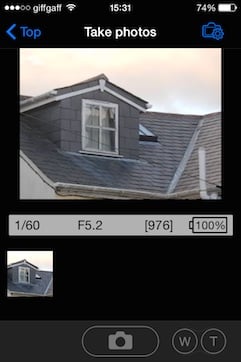 | 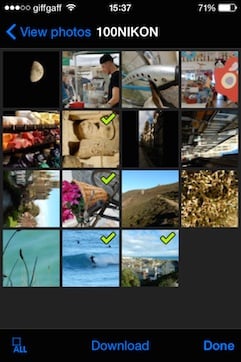 |  |
The COOLPIX S9700’s Wifi features are basic, but they do the job. Wifi on the PowerShot SX700 HS is more polished, but in terms of remote shooting and download, you don’t get a lot more. However, the SX700 HS does allow you to connect to a printer or another camera over Wifi and you can also upload to social media and photo sharing sites via Canon’s Image Gateway platform.
The COOLPIX S9700 is also equipped with a GPS receiver which means you can automatically tag photos with geolocation data and display them on a map. A dedicated button on the rear panel activates a map display which shows your current location as well as the position of recently taken photos. There’s a POI database which shows local points of interest and these can also be embedded in the image metadata.
During shooting the GPS reception strength is indicated on screen by a three bar graphic. On the whole I found the COOLPIX S9700 picked up a signal reasonably quickly and I had few problems with reception, though I wasn’t often in heavily built up areas. There’s also a compass heading display and when you play back images a small graphic indicates the direction you were facing when you took them. The latest S9900 keeps the GPS receiver, which makes it unique among the 2015 models as both Canon and Panasonic have now dumped GPS hardware from their 30x models, and Sony is yet to update its 2014 model.
The COOLPIX S9700 has two full resolution modes at 6.9fps and 2.1fps. The faster of the two shoots a 5-frame burst, focus and exposure are fixed on the first frame for all continuous shooitng modes. There are two faster settings that shoot 1280×960 images at 60fps and 640×480 at 120fps. There’s also a clever Pre-shooting cache mode that starts recording when the shutter is half pressed; when you fully press the shutter the COOLPIX S9700 captures a burst of 25 1280×960 frames at 20fps including up to 5 cached frames from before the shutter was fully depressed. Additionally, like most Nikon compacts The COOLPIX S9700 includes the Best Shot Selector mode which shoots a quick 10-frame burst and saves the sharpest to the card, discarding the others. Finally, Multi-shot 16 shoots 16 images and combines them in a 4×4 grid.
To test the continuous shooting on the COOLPIX S9700 I fitted it with a freshly formatted 8GB Sandisk Extreme UHS-1 card rated at 45Mb/s. I selected the best quality Large Fine JPEG setting and set the drive mode to the fastest full resolution 6.9fps Continuous H mode. The COOLPIX S9700 fired a burst of five shots at a slower than expectd 4.7fps. Reducing the quality to Normal resulted in a slight increase to 5fps. Though it’s a short burst that captures under a second of action, the COOLPIX S9700 does at least provide a wealth of faster lower resolution options for capturing longer sequences.
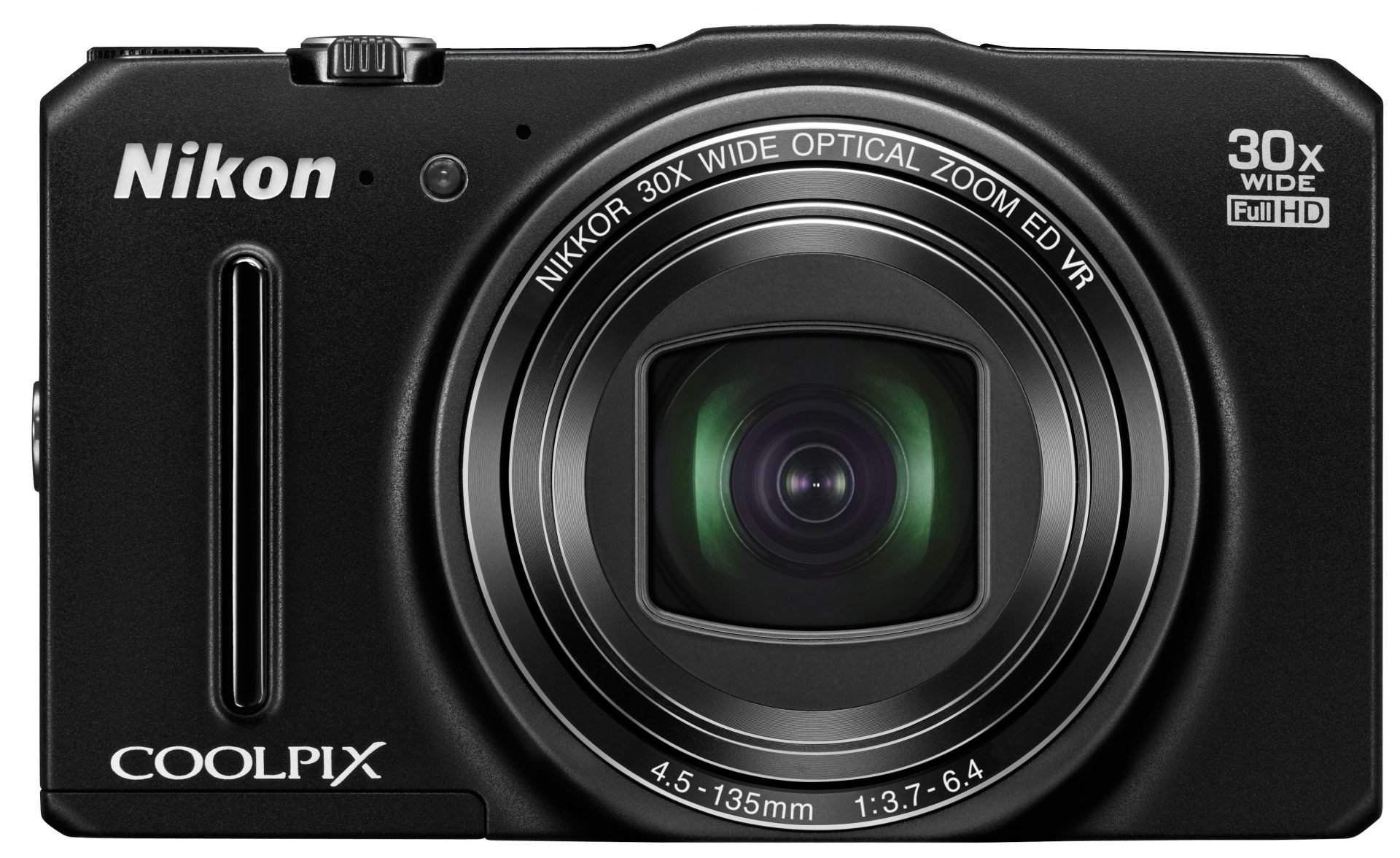
 Nikon's COOLPIX S9700 is a pocket super-zoom with a 30x optical range, taking you from 25mm wide angle to 750mm super-telephoto. This 16 Megapixel camera also offers 1080p video, full manual control, and uniquely among its latest rivals, both Wifi and GPS built-in.
Nikon's COOLPIX S9700 is a pocket super-zoom with a 30x optical range, taking you from 25mm wide angle to 750mm super-telephoto. This 16 Megapixel camera also offers 1080p video, full manual control, and uniquely among its latest rivals, both Wifi and GPS built-in.